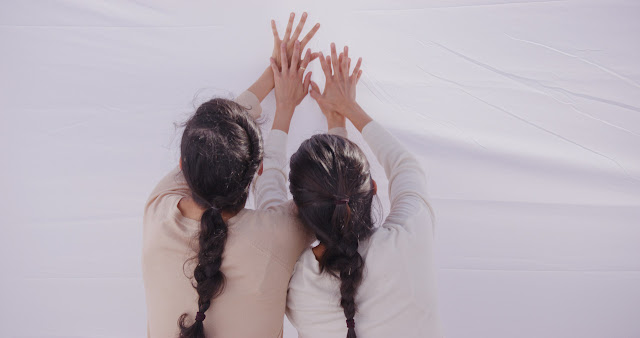 |
| Leah Terada, rear, looks over Liane Aung's arm in A Liminal Space photo @ Henry Wurtz, courtesy Seattle Dance Collective |
When the pandemic started two and a half years ago, I (like
many fans of live performance) wondered what it would be like to live without the
very particular thrill of settling into my seat, alongside fellow audience
members, collectively anticipating a new dance, a new play, a new concert.
Somehow, we all adjusted to art’s new digital delivery
system. The dance world offered up everything from older recordings of live
shows to odd Zoom pastiches. As the pandemic dragged on, artists adapted to the
new norm, moving beyond simple video captures to create ingenious new work for our
small screens.
This fall most performance venues are welcoming back live
audiences, but Seattle Dance
Collective’s latest film offering, A Liminal Space, conceived
and directed by Henry Wurtz with choreographer Bruno Roque, reminded me, first,
that digital offerings are here to stay. Second, that they can be as evocative
and satisfying as a live performance.
 |
| Leah Terada crawls out from the white fabric cube photo @ Henry Wurtz |
A Liminal Space begins inside a white cloth cube.
Dancer Leah Terada lies on a bed of soil, her off-white pants and sweater
covered with dark loam as she rolls and writhes. She rises from the dirt and
spots a pinpoint of light, ripping through her fabric enclosure with the help
of fellow dancer Liane Aung, who is just outside. Together they dance on a wide
Puget Sound beach, their curved arms seemingly gathering in the sun and
salt-water breezes as they revel in their freedom.
The film moves both the cube and the dancers onto a grassy
meadow, then into a lush forest grove. Aung and Terada are dressed alike, in light
slacks and sweaters, their dark hair styled into identical single braids that
hang down their backs. Are they doppelgangers? Mirror images of the same
person? As Fabian ReimAir’s original score builds in momentum, the two women dance
in unison, circle one another, lie side by side, fingers lightly brushing up
against the other’s body.
 |
| Terada and Aung working together to escape the cube photo @ Henry Wurtz |
The concept is simple, maybe even simplistic: here’s what it’s
like to be caged up, then released. We all remember how it felt when we first
emerged from pandemic quarantine; how we felt when we first met up with
friends, family, even strangers, after months of enforced social distancing. We
were confined in our own versions of the white cube; slowly we were freed to
experience the wider world and to enjoy human interaction again. Roque’s choreography
performed by these two dancers, plus the magnificence of a Pacific Northwest
summer, combine to give A Liminal Space more heft than it might have had
in the hands of lesser artists.
Liane Aung, who left Olivier Wevers’ company Whim W’Him this
spring after several seasons, is a standout dancer. She imbues each movement
with a crisp clarity that draws the viewer’s eye. Leah Terada, a corps de
ballet dancer with Pacific Northwest Ballet, has a softer approach to Roque’s choreography,
although she’s no less compelling to watch. Together they create a physical
harmony that elevates this short film.
 |
| Leah Terada, photo @ Henry Wurtz |
Terada is having a moment of sorts, emerging from the
relative anonymity of PNB’s corps. Two years ago, she danced on a dock with
fellow PNB company member Miles Pertl in a lovely short film The Only Thing You See Now, another
Seattle Dance Collective commission. Terada was featured in several PNB
offerings last season, giving ballet audiences a chance to see her versatility.
And I was awed by her complete dedication to her art form while watching her
earlier this summer as she performed choreographer Eva Stone’s punishing solo,
one of a series created for Stone’s site-specific Sculptured Dance on
Whidbey Island.
The joy of a dance film like Wurtz’ A Liminal Space
is that we get a close, even intimate, view of Terada and Aung. We savor the
expression on Terada’s face when she first escapes her white cube, watch them
watch each other as they start a duet. We see how Aung gives a physical weight
to Roque’s choreography, the way she angles an elbow or crouches low into her
knees. Meanwhile Terada almost seems to float above Aung, her version of these
same movements seemingly weightless. These are details we’d miss if this dance was
performed live. In fact, A Liminal Space could never be live; it’s a
piece of art created by a camera intended for a screen. It’s beauty is
fleeting, like the tangy scent of the salt water carried on the breeze.
One of the many lessons the pandemic has reinforced is the
myriad ways performance can pack an emotional wallop. I now cherish each
opportunity to sit in a darkened theater, the tingle of anticipation before the
stage lights come up on a live show. But as I watched Terada and Aung whirling
on the sand in the early morning sunshine, I felt a different kind of joy. I’m
grateful for the way artists adapted to changed circumstances, the way they
found new ways to illuminate our collective human experience. Thanks to Seattle
Dance Collective for making a space for this to continue.

No comments:
Post a Comment